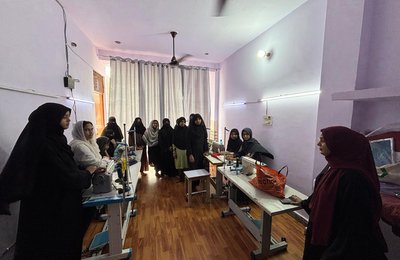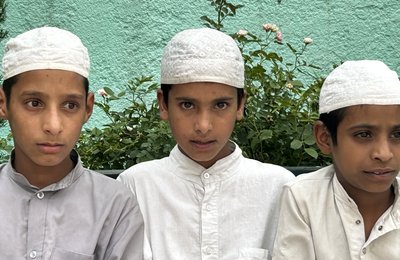If conflict prevention works why is it so little and so poorly understood?
Those interested in questions of international relations, justice and peace, and conflict and development should have no doubt about the value and importance of responding to the challenges of global armed violence with the “soft power” tactics of dialogue, negotiations and all that follows on from them. What some have called “peace by peaceful means,” or what many NGOs and the UN have come to call ‘building and sustaining peace’, covers a spectrum of interventions and roles to prevent and counter violence ranging from mediation to civil disobedience. But if these peacebuilding approaches work so well, why do we know so little about them? Why do they receive such small shares of national security and aid budgets? Why are they not prioritised by policy makers?
Of course, it’s also important to ask why these political ‘talking therapies’ are so dwarfed by military, ‘hard power’ and coercive responses, even though many senior military authorities might admit that wars are not really a winnable proposition these days. Nevertheless, peace advocates need to ask if, even on their own terms, nonviolent interventions are so important and so full of potentials, why are they so little seen and so poorly understood? What can we learn from that?
According to a recent report by the UN Secretary General, global expenditure on peace building in conflict-affected countries has declined, from 18% of ODA in 2009 to 13% in 2015. The Global Peace Index estimates this USD $6.8 billion is in contrast with the $14.3 trillion (or 12.6% of the world's GDP) spent annually meeting the costs and consequences of conflict. The UN General Assembly and Security Council have re-committed themselves to their Charter mandate of ‘ending the scourge of war’: and their new strategy to sustain peace (UNSCR 2282 – 2016). Along with the World Bank they have recently published their current thinking conflict prevention in a report, entitled Pathways for Peace. Of course, these multilateral commitments to prevention sit alongside the countervailing politics of force of multiple member states.
So, here’s a challenge, however you follow your news, keep an eye out for stories of violence averted, ceasefires reached, wars ended, and the legacies of violence addressed. Look out for who did what to influence and bring about the change. What do you notice? Of course, wherever you live, there will be headline news of violence, conflict and crises, news which by its very nature is inevitably shaping the decisions, calculus and behaviours of men (and women) in combat and political decision-makers.
As someone with a career of working in the field of conflict resolution I have long been interested in learning from people who played various roles in peace processes. Many years ago at Conciliation Resources, we set up the Accord series documenting the narratives of peace processes told by those with first-hand experience. This online journal is one of several initiatives set up to promote learning from peace negotiation and practice. For groups in conflict, such materials and exposure to other historic peace processes have played a key role in in influencing their decisions on whether and how to move out of violence and into politics.
With this agenda in mind and the help of Factr.com, an application for finding, organising and sharing information, colleagues and I set out to create a news-feed that captures and aggregates stories of peacebuilding and mediation from around the world with the intention of making them freely available to anyone seeking to follow and learn from what works (and what hasn’t) in other peace processes. It is a simple idea, and there are many other excellent online journals and social media accounts which aim to promote a similar agenda. Our stream is called Peace Talks, which now also feeds a Twitter account under the same name @PeaceNewstream.
In putting together this project I have come to learn a number of important things about the peacebuilding sector and its communications and more generally about the global challenge of preventing, ending and transforming armed conflicts. Here are my headlines:
Peacebuilding is a field without boundaries
It is a porous field with people, organisations and governments playing multiple and fungible roles.
While universities teach it, governments fund it, UN organisations do it and thousands of international and national organisations practice it, nevertheless, there are no agreed boundaries to the professional sector of peacebuilding. There is no consensus on what roles and activities fall within it and which fall outside. It is a porous field with people, organisations and governments playing multiple and fungible roles.
To create the newsfeed, we had to define terms of what to include and what to exclude. Our first principle was to subvert the idea of “if it bleeds it leads, and if it’s silent its nonviolent.” So, we leave out the updates on war and violence and conflict and include only stories about what is being done outside the military (and humanitarian) spheres in response to influencing the course of organised violence. But the twin challenges have been to be inclusive enough with our search words so as not to miss interventions aimed at transforming a conflict, while being focussed enough to exclude stories of efforts that were not pursued with the over-arching goal of building and sustaining peace, or they remained neutral in their goal and effect with regards to that question or were aiming to win the peace through violence and coercion.
While we might not know where the edges of the field lie, mediation is popularly considered to be very much at its centre. There are multiple efforts underway to ensure that these roles are more evenly shared between men and women. But while there are many special representatives or facilitators appointed by third parties, mediators accepted as such by negotiating conflict parties are surprisingly rare in peace processes and their agreements (search for yourself on the new PA-X [peace agreement access] database). Peace efforts and initiatives are multiple and diverse and only rarely in the form of mediation. These multiple paths are clearly illustrated in the excellent new resource from the Quaker Council for European Affairs, Building Peace Together.
Diplomacy is still the dominant form of international peacebuilding
If the twenty-four thousand stories in this English-language stream over the last six months are broadly representative, preventive or peace diplomacy is alive and well. By far the most reported stories are those of diplomats visiting other diplomats, states urging or encouraging other states to engage in peace processes accompanied by photos of (usually men) shaking of hands or in facing armchairs. Whether these stories reflect that diplomacy is having the greatest influence or that it is the area where most peacebuilding efforts lie, I wouldn’t want to say. These represent our formal and highly ritualised world of real power politics. Of course, behind those handshake photos there is an unreported world of intelligence, sanctions, incentives and trade-offs.
The most dynamic peace processes are not all the same as the world's worst crises
The top ten “crises to watch” as identified by the International Crisis Group at the beginning of this year are not entirely the same as the top ten peace processes to watch, i.e. those with the most significant and frequent developments as reported in public media. Perhaps that is a project that needs doing? It would be interesting to reflect on what it is that is driving these peace processes in contexts that are not in the top of the in-trays of the members of the Security Council. Could there be ways in which these benefit from not being the object of powerful nation’s projected strategic interests and public attention? Perhaps there is a broader lesson on the risks and consequences of focussing on the urgent at the expense of the important, and for those with a commitment to resourcing effective peacebuilding to spend more of their energies supporting and amplifying what is working?
How do we make the invisible (more) visible?
The problem with much, or even most of these [peacebuilding] stories is that they are hidden in plain sight and neither widely seen nor widely (enough) read.
Of course, the nature of many forms of peacebuilding engagement (notably difficult dialogues between traumatised conflict parties) is discrete by nature and has an antithetical relationship with the media. I was told that the private Swiss mediation organisation, the Centre for Humanitarian Dialogue, employs a consultant to keep them out of the news. Inevitably this aversion to publicity will contribute to why initiatives and stories are under-reported. We know that there is a great deal of unofficial peacebuilding work being done by local organisations with and without the help national and international NGOs that goes under-reported. Academic researchers are finding ways of documenting and studying these interventions.
Why is it then that, even when we are actively looking for them, stories of such unofficial, people-based, unofficial interventions are so hard to find? International NGOs in this field, large and small, and their national and international networks and platforms are very actively advocating for the value of what is often referred to as ‘locally owned and locally-led civil society peacebuilding’. They also make the case that significantly more funds should be invested in building and sustaining peace at every level. A great deal of funding and effort is being spent on communicating this agenda, resulting in creative peace journalism, characterised by moving human stories, wonderful films and recordings and dynamic info-graphics. The problem with much, or even most of these stories is that they are hidden in plain sight and neither widely seen nor widely (enough) read. For funded civic peacebuilding the vast amount of documentation (reporting and evaluations) disappears into the filing systems of donor agencies never to be seen or read again. Of course, publicly-oriented INGOs work hard to document, distribute and amplify these stories. Whether intentionally or not, and for both technical (lack of RSS permissions) and linguistic reasons, only a small percentage is accessible through search engines or shared platforms. Most require that the reader makes a visit or signs up to a website. I don’t know about you, but I find life is too short to spend much more time browsing organisational websites.
By their very nature, armed conflicts are complex phenomena. As such they generate a constant and bewildering flow of information that is both impossible to keep on top of and to wholly understand. Globally, if we are going to have more influence and impact on peaceful change, we are going to need to find better ways to navigate these information flows. Add to this challenge, for those of trying to ‘make sense of the world’ with the web and the increasing capabilities of our ubiquitous devices, we have too much connectivity and it is overwhelming and, in a way, also disempowering.
Opening access to seeing the interconnections and interdependent responses to conflict
If peacebuilding (both official and unofficial) is going to be better understood, better resourced and prioritised, peace journalism needs to be less backward in coming forward.
Perhaps the most important lesson I am learning from the Peace Talks project reinforces what I have learned from working for many decades in this sector. Whether you represent a government, a UN agency, a community-based organisation or an international NGO, the reality is that you have no overall control over either winning a war or winning the peace. Our conflict transforming aspirations are both interconnected and symbiotic. This truth is at the heart of peacebuilding. But the realities of our limited control and interdependence go hand in hand with those of our shared potentials. These are limited not only by our capacities and our imaginations but also by the institutional needs and interests that can get in the way. These can mean organisations work in competition with one another, choosing to operate in separate ‘siloes’ that ultimately inhibit our realising our collective and cumulative potentials to prevent violence and build peace.
If peacebuilding (both official and unofficial) is going to be better understood, better resourced and prioritised, peace journalism needs to be less backward in coming forward. It is going to have to find and use a vocabulary of plain speech that is shared with and understood by its readers. The way we distribute and consume our peace news is going to have to pay more attention to tactics of greater accessibility, breaking down the barriers so that our stories and our work can be seen together and add up to real change.







